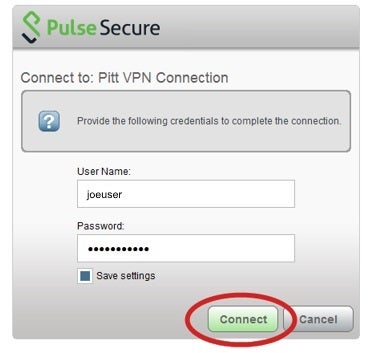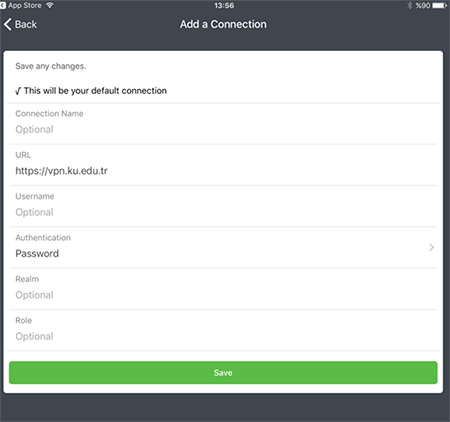- Pulse Secure recommends that customers deploy the latest version of Pulse Secure software for their use case and to include password update frequency in their corporate security policy. For more information on security best practices please visit KB29805. Security Advisory Alert (Updated September 23rd, 2020).
- Pulse clients connect to the Pulse Connect Secure in SSL fallback mode. Connections to Juniper Networks SRX Series gateways. MacOS endpoints can connect to SRX Branch series SRX100-SRX650 gateways that are running a Junos OS release between v10.2 and v12.3, and that have dynamic VPN access enabled and configured.

Overview
Refer to the supported OS list on the FAQ page. Download the Pulse Secure client for MacOS here. Open the package, click Continue, then Install. Note: If you are having trouble finding the file after download, trying looking on your desktop or in the downloads folder located in the Dock. Click Close once installation is.
To connect to Indiana University's SSL VPN for individuals from your Windows or macOS workstation, use the Pulse Secure SSL VPN client available from IUware.
Pulse Secure Download For Mac
Pulse Secure lets you connect directly to IU's SSL VPN without having to log in through a web browser. It replaces Junos Pulse and Network Connect, two VPN clients you may have used previously.
- Use the IU VPN only under one of these conditions:
- If you are trying to access a service you can't get to another way.
- If your IT Pro has told you that you need to use it.
Generally, you won't need to use the VPN if you are a student. For example, you don't need a VPN connection to:
- Use learning tools, such as Canvas, Zoom, or Kaltura.
- Read your IU email over the web.
- Work with your files in Box.
- If you have difficulty with the VPN: Try using IUanyWare (doesn't require a VPN connection).
For example, you can use IUanyWare's Remote Desktop Connection app to remote into a device on campus. Additionally, IUanyWare's Chrome browser allows you to access sites as if you were on campus.
In IUanyWare, search the available apps to find what may be helpful.
- On the IU network: You cannot connect to the VPN, as it is for off-campus use only.
If you receive a 1329 error when attempting to connect to the VPN, try connecting using a non-eduroam or non-IU Secure connection.
- To ensure accountability of network communication, the University Information Policy Office prohibits group accounts from connecting to IU's SSL VPN. To make a VPN connection, you must log in using your personal IU username and passphrase.
- For general VPN usage, you can connect one device at a time. If you connect a second device while you already have a connection running to another device, you'll see a prompt asking whether you want to maintain the existing connection and cancel the new connection request, or break the existing connection and establish a new connection. Groups VPN users can connect two devices concurrently.
Install Pulse Secure
IU students, faculty, and staff can download Pulse Secure from IUware:
By default, macOS may let you install applications from verified sources only; consequently, when you try to install Pulse Secure, you may see an error similar to 'ps-pulse-mac.dmg can't be opened because it is from an unidentified developer.' To bypass this error (for this application only) and manually install Pulse Secure:
- While holding
control, click the application's icon, and then, from the drop-down that appears, select Open. - In the new window, click Open to manually launch Pulse Secure.
Configure the connection
- Open Pulse Secure to configure it for your first use:
- Windows: In your task bar, click the Pulse Secure icon ().
- macOS: In the menu bar, click the Pulse Secure icon (). Alternatively, find and click the Pulse Secure icon in your
Applicationsfolder. (If you have trouble finding a Pulse Secure folder, check for one namedJunos Pulse Secure.)
- To add a new connection, click + (the plus sign).
- In the 'Add Connection' box:
- Type: Make sure Policy Secure (UAC) or Connect Secure (VPN) is selected.
- Name: Enter a name (for example,
IU VPN) to distinguish this connection from other VPN connections you may configure (for example, to the Groups or HSN VPN; see the note below). - Server URL: Enter
https://vpn.iu.edu.
- Click Add.
If you use the IU Groups VPN or Health Sciences Network (HSN) VPN, add an additional connection using the appropriate URL:
- Groups VPN: https://vpn.iu.edu/groups
- HSN VPN: https://vpn.iu.edu/hsn
For more about these VPNs, see:

Connect and disconnect
To connect to the IU SSL VPN:
- Open Pulse Secure:
- Windows: From the task bar, right-click the Pulse Secure icon, and then choose Connect.
- macOS: From the menu bar, click the Pulse Secure icon, choose the SSL VPN profile you created, and then click Connect.
- Enter your IU username and passphrase, and then click Connect.
- In the 'Secondary Password' field, enter one of the following:
- A passcode (for example,
123456): Generated by Duo Mobile, an SMS text, or a single-button hardware token push: Sends a push login request to the Duo Mobile app on your primary smartphone or tabletphone: Calls your primary phone number (whether mobile phone or landline)sms: Sends a new SMS passcode to your primary device; once you receive the passcode via SMS, enter it into the 'Secondary Password' field.Enteringsmswill cause the initial login to fail with a 'Credentials were invalid. Please try again.' error message. However, you also will receive a text message with a passcode to enter in the 'Secondary Password' field.If you have more than one device of a certain type registered (such as a second smartphone or tablet), you can add a number to the end of your secondary password to direct login requests to a particular device (for example,push2will send a login request to your second phone;phone3will call your third phone).
- A passcode (for example,
- Click Connect.
Pulse Secure 9.1 Download

Pulse Secure Client Download Mac
When the VPN connection is established, you can exit Pulse Secure and access IU network resources that require a VPN connection. To disconnect from the VPN:
- Windows: Right-click the Pulse Secure icon, and then select Disconnect.
- macOS: Click the Pulse Secure icon, and then, from the SSN VPN profile menu, select Disconnect.
Pulse Secure Mac Client
Qualified and compatible platforms
To ensure that you can connect to the IU VPN, verify that you are running the latest version of Pulse Secure available on IUware. For operating system requirements and recommendations, see the 'Pulse Secure Desktop Client Supported Platforms Guide' available at Pulse Secure Techpubs.
Pulse Secure Download Macos Catalina
- Download Pulse Secure installer from the link below:
PulseSecure.dmg - Install Pulse Secure.
- Enter your macOS Username and Password:
At the end of the installation, click Close. - Put the Pulse Secure on the Dock:
- Click on Pulse Secure and then click on the plus sign:
- Fill the connection data, Name – Technion, Server URL — https://vpn.technion.ac.il/
- Then click on Add button.
- Now you have your connection ready:
- Click on Connect.
- Enter your full credentials in form username@<domain> as described below. In the password field, enter your PIN code and a code from your authentication app. The two codes should be together without any space; and click Connect.
- Staff users – username@technion.ac.il
- Students — username@campus.technion.ac.il
- ASAT users — username@asat.technion.ac.il
